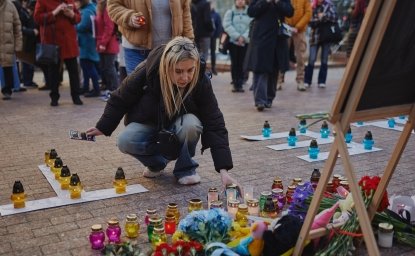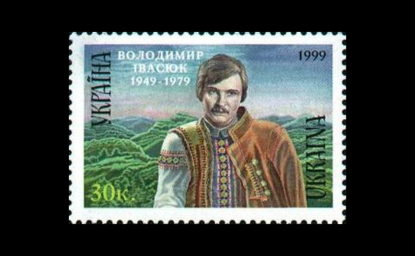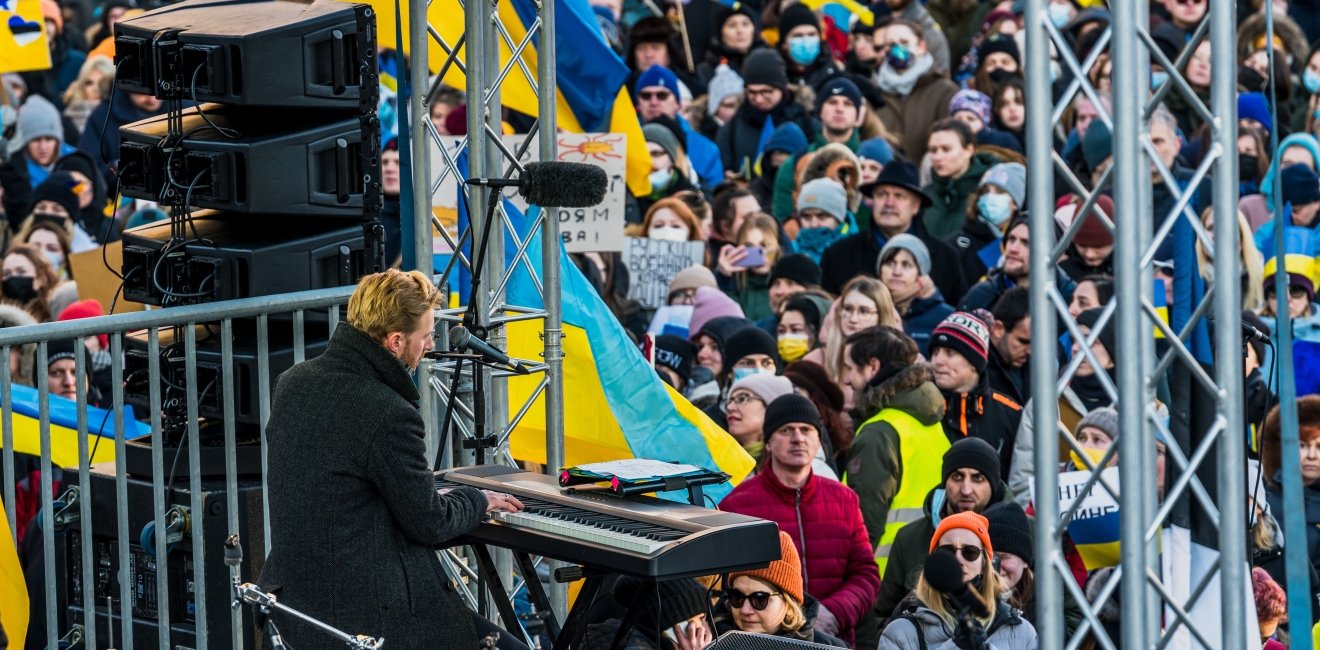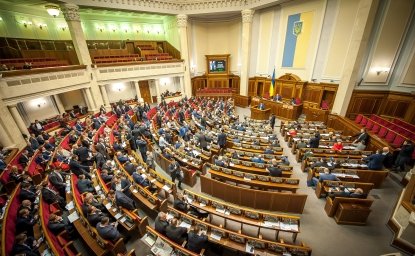
A blog of the Kennan Institute
BY BLAIR A. RUBLE
The world has been moved by images of a young Ukrainian girl singing “Let It Go” in basement bomb shelters; newly arriving Ukrainian refugees sitting down at a piano outside a Polish train station to play “It’s a Wonderful World;” and gatherings of Ukrainian heroes belting out the Ukrainian national anthem. Music provides solace and courage in a world turned upside down. These responses to the chaos of war are powerfully human. As Ukrainians long have understood, music and the arts proclaim who we are.
Readers looking to a powerful new wave of postindependence Ukrainian literature—written in Ukrainian, Russian, and other languages—have long appreciated the depth of a new Ukrainian identity that was finding expression on the printed page. Enthusiastic concertgoers have turned to local symphonic orchestras and opera houses for emotional grounding. Ukrainian hip-hop provided the soundtrack to Ukraine’s 2004 Orange Revolution and the 2013–14 Euromaidan uprising. TV melodramas and comedy series uncovered new national leaders. Researchers and artists associated with the Ukrainian Academy of Arts’ Contemporary Art Research Institute set out to redefine the arts in accord to what was happening elsewhere. Perhaps more than Ukraine’s often fractious political system, the arts quietly and profoundly defined a new Ukrainian nation.
I witnessed the power of the arts to proclaim Ukrainian national identity firsthand nearly a decade ago when a night at the ballet turned into a lesson in Ukrainian self-assertion. Rhythmic hip-hop-like chants of protest exploded just as the final curtain came down on the flower-laden ballet dancers and the musicians who had performed with them. Within seconds, the bright lights of the TV crews who had forced their way into the orchestra seats overwhelmed the still dim house lights when suddenly—as if on a cue from a cameraman—four white banners unfurled from the fourth balcony, enveloping the hall below.
To ever louder chants of “Hanba! Hanba! Hanba!” (“Shame! Shame! Shame!”), streamers cascading from the upper balcony demanded that the National Ballet of Ukraine retain the company’s artistic director, Denys Matvienko. The sumptuous Kyiv Opera House exploded in chaos after a stunning performance on April 13, 2013.
The National Ballet of Ukraine has managed to remain a national treasure despite all the political, financial, and artistic upheavals of the past three decades. Like many other Soviet companies, the Kyiv ballet needed a dusting off once the country fell apart and cultural institutions long dependent on state munificence were tossed into the international arts marketplace.
The company’s ballet school continued to produce a steady stream of world-class performers—especially male dancers—who headed out across the globe. Often they signed with international companies. New York’s American Ballet Theater hired numerous Kyiv-trained soloists and corps members of note. Kyiv dancers nonetheless returned home whenever their schedules permit them to take time away from leading companies in Moscow, St. Petersburg, London, and New York. The company became, as former U.S. ambassador to Ukraine William Green Miller once quipped, “the best company money can’t buy.”
Denys Matvienko was among those who chose to return. A native of Dniepro, Matvienko spent his career dancing in Kyiv, while serving as a leading soloist in Moscow, St. Petersburg, New York, Tokyo, and Milan. Approaching his mid-thirties, he was lured back to Kyiv in November 2011 to serve as the company’s artistic director and to perform whenever possible.
Matvienko set about introducing contemporary ballets to the company’s repertoire. He added verve to the standard repertoire. For example, he replaced Marius Petipa’s well-worn choreography for Ludwig Minkus’s La Bayadère with a more modern and energetic 1980s version choreographed by Natalia Makarova for London and New York audiences. Simultaneously, Matvienko invited innovative contemporary artists to bring their works to Kyiv, including Edward Clug, a Romanian dancer whose striking choreography made the Slovene National Theater one of the most exciting companies of its size anywhere.
Matvienko’s leadership symbolized everything that post-independence Kyiv youth wanted for their country: something that was fresh, high energy, edgy, and internationally appreciated, especially in the West. They welcomed his regime as a symbol of a new Ukraine that would be within their grasp if only their country’s boorish, traditional-in-a-Soviet-sort-of-way, and corrupt leaders would just get out of their way.
A couple of days before the April 13 eruption inside the Kyiv Opera House, the leadership of the theater and their masters at the Ukrainian Ministry of Culture—run by particularly distasteful cronies of the country’s convicted criminal turned president, Viktor Yanukovych—“fired” Matvienko as the company’s artistic director. Citing artistic and personal differences, the Opera Theater’s management revealed in a bizarre announcement that Matvienko had never been “hired.” Evidently, once Matvienko signed his contract in November 2011, management sent his employment documents to superiors, who never bothered to countersign.
The raucous upper balcony protestors in Kyiv that evening and their sympathetic supporters in the lower tiers were going far beyond showing support for their dismissed idol. They were proclaiming their collective disgust with the incompetent and corrupt state officials who forced him to leave.
After having experienced this visceral rejection of a pro-Russian Ukrainian regime by happening to have attended the ballet that evening, I was not at all surprised when that regime crumbled a few months later. I also am unsurprised by today’s brave resistance to Russian invaders. I now understood better than ever before that the arts give voice to our deepest emotions, often revealing them to ourselves and to others before they find formal expression through more purposeful words and deeds.
Perhaps hard-nosed observers consider the music little more than white noise; or a human interest aside to reporting on a brutal war. If so, we miss the much larger story of social and political change. The performing arts, as communal and social activities, bring humans together in all their agreements and disagreements. They express some of the deepest human emotions and, in response, intensify our innermost passions. What happens when performers meet their audiences signals how we see ourselves and our futures; and how we like what we see, or not.
The Russian army appreciates this truth more than many political commentators have. Russian rockets have targeted the Kharkiv Opera House; defenders of Odesa understand their historic and internationally renowned Opera House may be next.
A night at the theater, the concert hall, or a night club is always about more than an entertaining backdrop to the political and economic forces that really matter. As Robert Ferris Thompson tells us in his masterful Tango: The Art History of Love: “First, culture is forever. It is politics and ego that fades.” A lesson Putin’s Russia needs to learn.
The opinions expressed in this article are those solely of the authors and do not reflect the views of the Kennan Institute.
Author

Former Wilson Center Vice President for Programs (2014-2017); Director of the Comparative Urban Studies Program/Urban Sustainability Laboratory (1992-2017); Director of the Kennan Institute for Advanced Russian Studies (1989-2012) and Director of the Program on Global Sustainability and Resilience (2012-2014)

Kennan Institute
After more than 50 years as a vital part of the Wilson Center legacy, the Kennan Institute has become an independent think tank. You can find the current website for the Kennan Institute at kennaninstitute.org. Please look for future announcements about partnership activities between the Wilson Center and the Kennan Institute at Wilson Center Press Room. The Kennan Institute is the premier US center for advanced research on Eurasia and the oldest and largest regional program at the Woodrow Wilson International Center for Scholars. The Kennan Institute is committed to improving American understanding of Russia, Ukraine, Central Asia, the South Caucasus, and the surrounding region through research and exchange. Read more

Explore More in Focus Ukraine
Browse Focus Ukraine
Talking to the Dead to Heal the Living

Ukrainian Issue in Polish Elections


